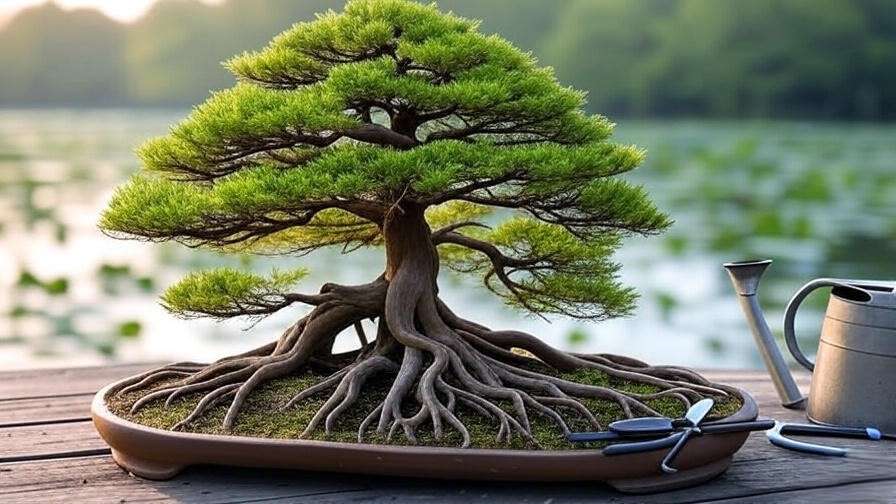Imagine transforming a piece of North American wilderness into a miniature masterpiece that fits on your tabletop—a bald cypress bonsai tree, with its feathery foliage and evocative swamp-like charm, can do just that. Whether you’re a novice bonsai enthusiast or a seasoned grower, the bald cypress (Taxodium distichum) offers a unique blend of beauty and resilience, making it an ideal choice for creating a stunning bonsai. As a horticulturist with over a decade of experience specializing in native tree cultivation, I’ve seen firsthand how this forgiving species can thrive with the right care. In this comprehensive guide, we’ll walk you through every step of growing and maintaining a bald cypress bonsai tree, addressing common challenges like overwatering or improper pruning to ensure your success. From selecting the perfect tree to mastering advanced styling techniques, this article is your roadmap to cultivating a breathtaking bonsai that captivates and inspires. 🌿
1. Understanding the Bald Cypress Bonsai Tree 🌲
1.1 What Makes the Bald Cypress Bonsai Unique? 🪴
The bald cypress, a deciduous conifer native to the wetlands of the southeastern United States, is unlike traditional bonsai species. Its soft, needle-like leaves turn a striking bronze in fall, shedding annually to reveal a rugged, textured trunk. This seasonal transformation adds dynamic visual interest, setting it apart from evergreen bonsai like pines or junipers. The bald cypress’s iconic “knees”—root-like structures that emerge in its natural habitat—can be replicated in bonsai form, creating a miniature swamp aesthetic that’s both dramatic and authentic.
What makes this species particularly appealing for bonsai is its adaptability. It thrives in a variety of climates, tolerates wetter soils than most bonsai, and forgives minor care mistakes, making it perfect for beginners. Its versatility allows for multiple bonsai styles, including formal upright, informal upright, or even forest arrangements, each highlighting its unique character. 🌴
1.2 Benefits of Growing a Bald Cypress Bonsai 🌟
Cultivating a bald cypress bonsai is more than a hobby—it’s a meditative journey. Studies, like those from the American Horticultural Therapy Association, show that bonsai care promotes mindfulness, reduces stress, and fosters patience. The bald cypress’s forgiving nature makes it an excellent choice for those new to this art form, offering a low-stakes entry into bonsai cultivation.
Environmentally, this species adapts well to both indoor and outdoor settings with proper care, making it accessible to growers in diverse climates. A well-maintained bald cypress bonsai can live for decades, becoming a cherished heirloom that tells a story of care and dedication. Its seasonal color changes also make it a living piece of art, evolving with the seasons. 🍂
2. Choosing the Right Bald Cypress Bonsai 🌿
2.1 Selecting a Healthy Tree 🧐
Choosing a healthy bald cypress bonsai is the foundation of your success. Look for vibrant, green foliage during the growing season, a firm trunk, and a robust root system. Avoid trees with yellowing needles, soft bark, or signs of pests, as these indicate stress. Young trees (2–5 years old) offer more styling flexibility, while mature specimens provide instant visual impact but may require advanced techniques to shape.
When purchasing, check the root ball for firmness and ensure the tree is potted in well-draining soil. A healthy bald cypress should have a balanced structure, with branches evenly distributed to support your desired bonsai style. Expert Tip: Tap the trunk gently—if it feels hollow or overly soft, the tree may be unhealthy. 🩺
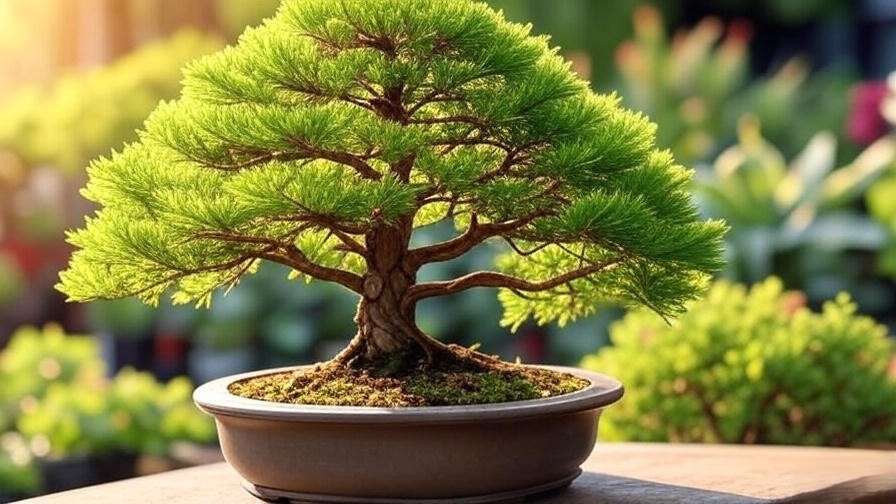
2.2 Best Sources for Bald Cypress Bonsai 🌍
You can source bald cypress bonsai from reputable nurseries, bonsai specialty shops, or local bonsai clubs. Online retailers like Bonsai Outlet or Evergreen Gardenworks offer pre-bonsai stock, while local nurseries may carry young trees suitable for training. Starting from seed or cuttings is rewarding but time-intensive, taking 2–3 years to develop a trainable structure. Pre-bonsai stock, typically aged 3–5 years, strikes a balance between affordability and immediate styling potential.
Here’s a quick comparison of sourcing options:
| Source | Cost | Availability | Quality |
|---|---|---|---|
| Local Nursery | $20–$50 | Moderate | Varies |
| Bonsai Specialty Shop | $50–$200 | High | High |
| Online Retail | $30–$150 | High | Moderate to High |
| Seeds/Cuttings | $5–$15 | High | Requires Patience |
Expert Insight: Join a bonsai club to access workshops and healthy stock from experienced growers, ensuring you start with a quality tree. 🌱
3. Essential Care Requirements for Bald Cypress Bonsai 🛠️
3.1 Light and Location ☀️
Bald cypress bonsai thrive in full sun, requiring at least 6 hours of direct light daily to promote vigorous growth and vibrant foliage. If grown indoors, place near a south-facing window or supplement with a grow light (10,000 lumens, 12 hours daily). Outdoors, position in a spot with morning sun and afternoon shade in hotter climates to prevent leaf scorch.
In winter, protect your bonsai from temperatures below 20°F (-6°C) by moving it to a garage or unheated greenhouse. Rotate the tree every 1–2 weeks to ensure even light exposure, promoting balanced growth. Common Mistake: Placing the bonsai in low-light areas can weaken it, leading to sparse foliage. 🌞

3.2 Watering Needs 💧
Unlike most bonsai, bald cypress loves moisture, reflecting its wetland origins. Keep the soil consistently moist but not waterlogged, watering daily during the growing season (spring–summer) and reducing to every 2–3 days in fall. Use a watering can with a fine nozzle to avoid disturbing the soil.
For indoor trees, maintain humidity by placing the pot on a tray filled with pebbles and water, ensuring the pot’s base doesn’t sit in standing water. Expert Tip: Test soil moisture with a chopstick—if it comes out dry, water immediately. Overwatering, though rare for this species, can cause root rot, so ensure proper drainage. 🚿
3.3 Soil and Potting 🪴
The ideal soil mix for bald cypress bonsai is well-draining yet moisture-retentive, such as 50% akadama, 30% pumice, and 20% organic compost (pH 5.5–6.5). Repot young trees every 2–3 years in early spring, trimming 1/3 of the roots to encourage vigor. Mature trees can be repotted every 4–5 years.
Choose a shallow, wide pot to mimic the tree’s natural root spread and enhance its swamp-like aesthetic. Ensure the pot has multiple drainage holes. Expert Insight: Sterilize soil and pots before repotting to prevent fungal infections. 🪵
3.4 Fertilizing for Growth 🌱
Fertilize your bald cypress bonsai biweekly during spring and summer with a balanced liquid fertilizer (10-10-10) diluted to half strength. In fall, switch to a low-nitrogen formula (5-10-10) monthly to prepare for dormancy. Avoid fertilizing in winter when the tree is dormant.
Organic options, like fish emulsion, promote soil health but may attract pests indoors. Chemical fertilizers offer precise nutrient delivery. Common Mistake: Over-fertilizing can burn roots, so always dilute and follow package instructions. 🌿
3.5 Temperature and Humidity 🌡️
Bald cypress bonsai prefer temperatures between 50–85°F (10–29°C) and can tolerate brief dips to 20°F (-6°C). Maintain humidity at 50–70%, especially indoors, using misting, humidity trays, or grouping with other plants. In winter, allow the tree to experience natural dormancy by keeping it in a cool (35–50°F/2–10°C), protected area.
Expert Tip: If humidity drops below 40%, use a room humidifier to prevent needle drying. Monitor with a hygrometer for precision. ❄️
4. Pruning and Shaping Your Bald Cypress Bonsai ✂️
4.1 Pruning Basics 🪚
Pruning is essential for maintaining the shape and health of your bald cypress bonsai. The best time to prune is late winter to early spring, just before new growth begins, as the tree is dormant and wounds heal quickly. Use sharp, sterilized bonsai shears to make clean cuts, removing dead or overcrowded branches to improve air circulation and light penetration. Pinch back new shoots to encourage compact growth, focusing on maintaining the desired silhouette.
For structural pruning, remove branches that disrupt the tree’s balance or grow inward. Thin dense foliage to prevent fungal issues, especially in humid climates. Expert Tip: Always cut at a 45-degree angle just above a bud to promote healthy regrowth. Avoid over-pruning, as this can stress the tree and reduce vigor. 🪴
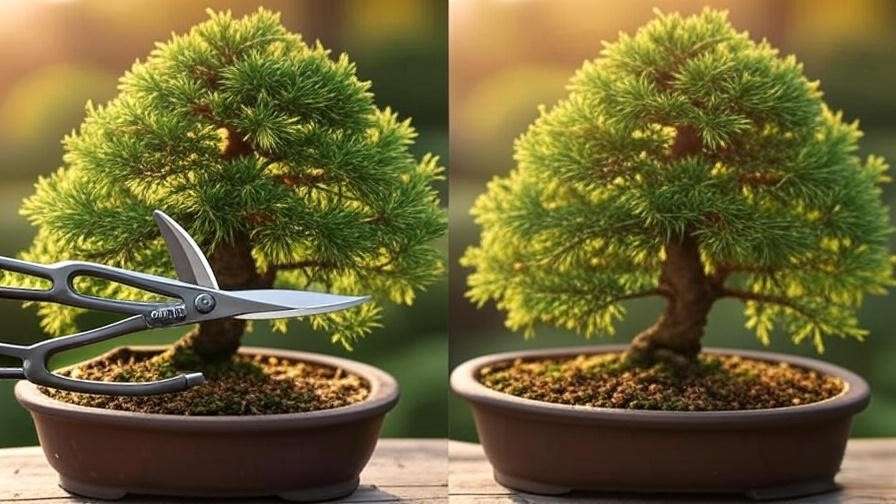
4.2 Wiring for Style 🪢
Wiring allows you to shape your bald cypress bonsai into stunning forms like formal upright, informal upright, or cascade. Perform wiring in early spring or late fall when branches are pliable, reducing the risk of snapping. Use aluminum or copper wire (1–4 mm, depending on branch thickness), wrapping at a 45-degree angle to avoid damaging the bark.
Step-by-Step Wiring Guide:
- Select a wire 1/3 the thickness of the branch.
- Wrap the wire snugly but not tightly, starting at the base and moving upward.
- Gently bend the branch into the desired shape, checking for tension to avoid cracking.
- Remove wire after 3–6 months, once the branch sets in place.
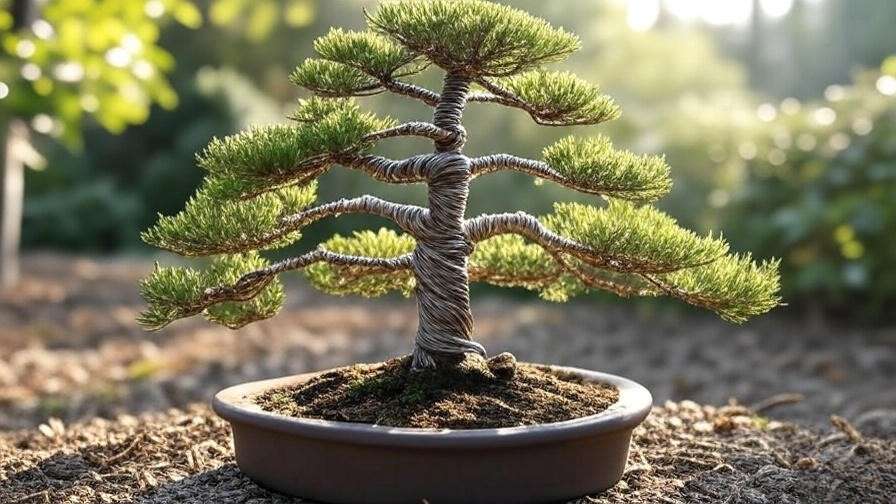
Common Mistake: Leaving wire on too long can cause it to cut into the bark, leaving scars. Check monthly and rewire if needed. Popular styles for bald cypress include informal upright for a natural, windswept look or cascade to mimic trees overhanging water. 🌊
4.3 Maintaining Proportions 📏
A balanced bald cypress bonsai has a harmonious ratio of trunk, branches, and foliage. Aim for a trunk-to-foliage ratio where the canopy is 1–2 times the trunk height for upright styles. Regularly thin upper branches to prevent top-heavy growth and encourage lower branch development for a tapered silhouette.
Expert Insight: Use a bonsai design sketch to plan your tree’s proportions before pruning or wiring. This ensures a cohesive aesthetic and prevents over-manipulation. Rotate the tree during styling sessions to assess symmetry from all angles. 📐
5. Common Problems and Solutions 🩺
5.1 Pests and Diseases 🐛
Bald cypress bonsai are relatively hardy but can face pests like spider mites, scale insects, and aphids, especially in dry or indoor conditions. Fungal infections, such as root rot or needle blight, may occur in overly wet or poorly ventilated environments.
Prevention:
- Inspect weekly for webbing, sticky residue, or discolored foliage.
- Maintain air circulation by thinning dense foliage and avoiding overcrowded plant groupings.
- Apply neem oil spray (diluted per instructions) monthly as a preventive measure.
Treatment:
- For pests, isolate the tree and use insecticidal soap or neem oil, applying every 7–10 days until cleared.
- For fungal issues, remove affected areas with sterilized tools and treat with a copper-based fungicide.
- Ensure proper drainage to prevent root rot.
Expert Tip: Quarantine new plants for 2 weeks to avoid introducing pests to your bonsai collection. 🧼
5.2 Troubleshooting Care Issues ❓
Here’s a diagnostic table to address common bald cypress bonsai problems:
| Symptom | Cause | Solution |
|---|---|---|
| Yellowing needles | Overwatering or nutrient deficiency | Check soil drainage; adjust watering; fertilize with 10-10-10 biweekly. |
| Stunted growth | Insufficient light or root-bound | Move to full sun; repot if roots are circling the pot. |
| Dropping needles | Underwatering or low humidity | Increase watering frequency; use a humidity tray or mist daily. |
| Soft, mushy roots | Root rot from poor drainage | Repot in well-draining soil; trim affected roots; treat with fungicide. |
Common Mistake: Ignoring early signs of stress can escalate minor issues. Regular monitoring and quick action keep your bonsai thriving. 🔍
6. Advanced Techniques for Stunning Results 🎨
6.1 Creating Realistic “Knees” 🌴
The bald cypress’s signature root knees—protrusions that emerge in swampy environments—add authenticity to your bonsai. To replicate this, expose surface roots during repotting by gently removing topsoil. Encourage knee formation by placing the tree in a shallow pot with a moist soil mix and occasionally submerging the base in a water tray for a few hours weekly.
For aesthetic enhancement, position small rocks around exposed roots to mimic a natural wetland scene. Expert Insight: Be patient—knees develop slowly over years, so focus on gradual root exposure to avoid shocking the tree. 🪨
6.2 Seasonal Styling for Visual Impact 🍂
Maximize the bald cypress’s fall bronze foliage by ensuring ample sunlight and balanced fertilization in late summer. To enhance color vibrancy, reduce nitrogen in your fertilizer (e.g., switch to 5-10-10) as autumn approaches. Prune lightly in early fall to shape the canopy, highlighting the tree’s seasonal transformation.
In winter, allow the tree to enter dormancy in a cool, protected area (35–50°F/2–10°C). This rest period strengthens the tree for a robust spring flush. Expert Tip: Display your bonsai on a wooden stand during fall to showcase its bronze hues against a neutral backdrop. 🍁
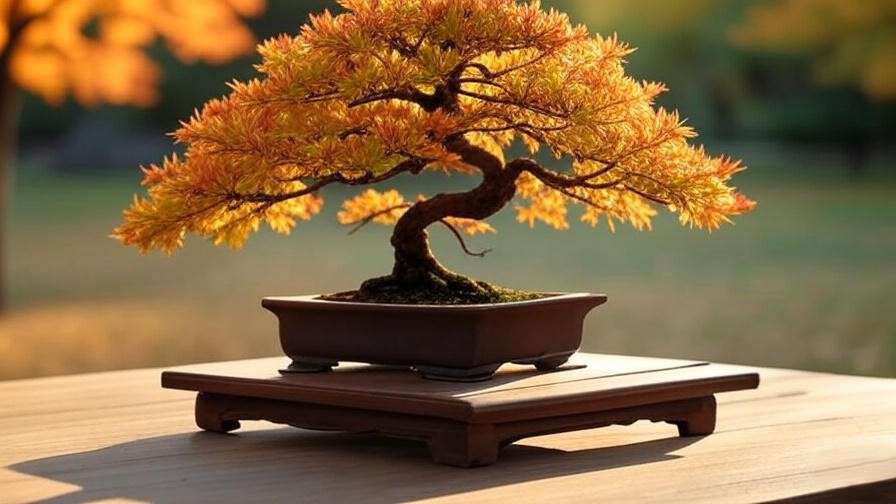
6.3 Long-Term Maintenance 🕰️
A mature bald cypress bonsai, aged 10+ years, requires consistent care to maintain its form and health. Focus on minimal pruning to preserve structure, repotting every 4–5 years, and monitoring for pests or nutrient deficiencies. Document your bonsai’s progress with photos to track growth patterns and refine your techniques.
Case Study: A 15-year-old bald cypress bonsai I cultivated started as a nursery seedling. Through careful wiring, root knee development, and seasonal pruning, it now features a thick trunk, intricate knees, and a compact canopy, resembling a miniature swamp tree. This transformation took patience and consistent care, proving the rewards of long-term dedication. 📸
7. FAQs About Bald Cypress Bonsai Care ❓
Q1: Can a bald cypress bonsai grow indoors year-round?
A: Yes, with ample light (south-facing window or grow light) and high humidity (50–70%). However, outdoor placement for at least part of the year promotes stronger growth and seasonal dormancy.
Q2: How often should I repot my bald cypress bonsai?
A: Young trees (2–5 years) need repotting every 2–3 years; mature trees every 4–5 years. Always repot in early spring before bud break.
Q3: Why are my bonsai’s needles turning yellow?
A: Yellowing may stem from overwatering, poor drainage, or nutrient deficiency. Check soil moisture, ensure proper drainage, and fertilize biweekly with a balanced formula.
Q4: Is bald cypress bonsai suitable for beginners?
A: Absolutely! Its forgiving nature and moisture tolerance make it an excellent choice for novices, provided basic care guidelines are followed.
Q5: Can I propagate a bald cypress bonsai from cuttings?
A: Yes, take 6-inch cuttings in late spring, treat with rooting hormone, and plant in a moist, well-draining mix. Expect rooting in 6–12 months with consistent care.
8. Expert Tips for Success 🌟
- Rotate Regularly: Turn your bonsai every 1–2 weeks to ensure even light exposure, preventing lopsided growth. 🔄
- Use Rainwater: Avoid tap water’s mineral buildup by collecting rainwater or using distilled water for watering and misting. 💦
- Join a Community: Connect with local bonsai clubs or online forums like Bonsai Nut for hands-on workshops and expert advice. 🤝
- Quote from a Master: Renowned bonsai artist John Naka once said, “Bonsai is not about control, but about harmony with nature.” Let your bald cypress bonsai guide your care approach. 🌳
9. Conclusion: Your Journey with Bald Cypress Bonsai 🌳
Growing a bald cypress bonsai tree is a rewarding journey that blends art, nature, and patience. By following this guide—covering selection, care, pruning, and advanced styling—you’re equipped to cultivate a stunning bonsai that reflects your dedication. Start with a healthy tree, master the basics of light, water, and soil, and experiment with shaping to create a miniature masterpiece. Whether you’re drawn to its swamp-like aesthetic or its seasonal beauty, your bald cypress bonsai will become a living testament to your care.
Share your bonsai journey in the comments below or explore our related articles on bonsai watering techniques and tool selection. Ready to start? Your bald cypress bonsai awaits! 🌿

